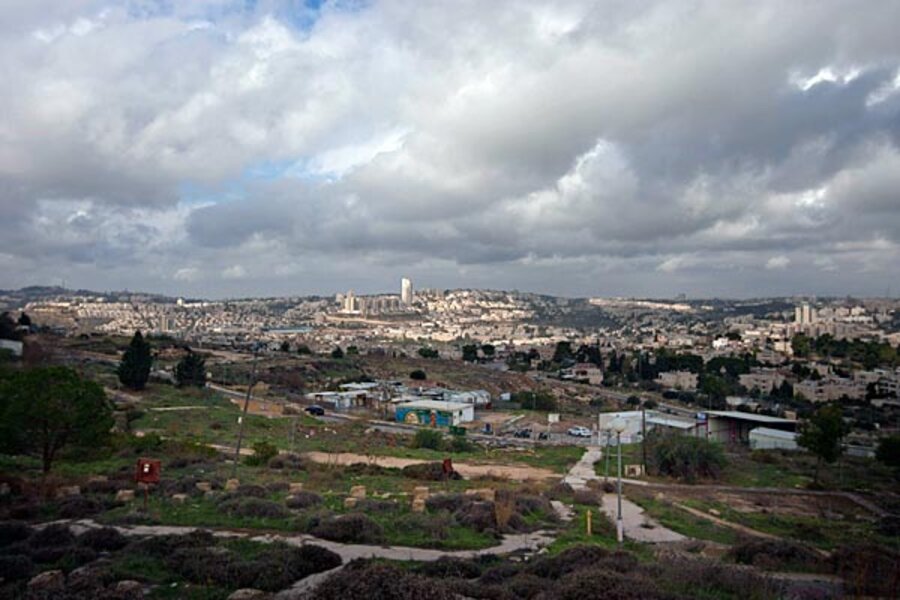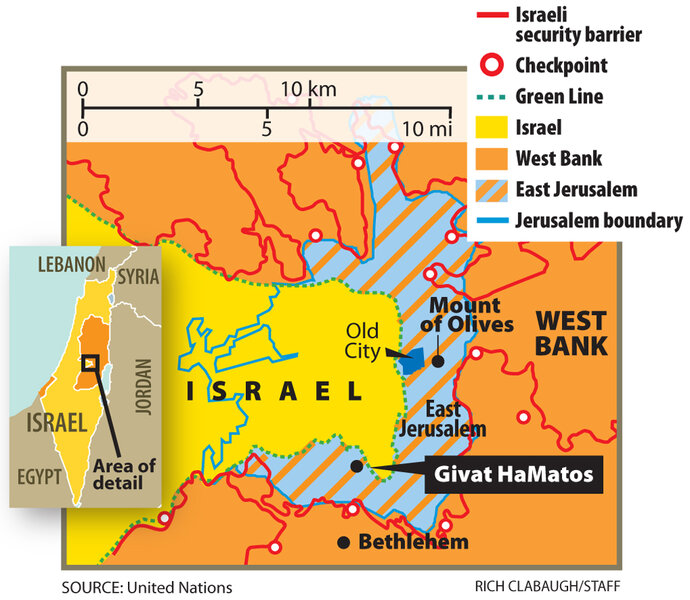Israel moves to further seal off Jerusalem from West Bank
Loading...
| Jerusalem; and Bethlehem, West Bank
Israeli officials today approved plans for 2,612 new homes to be built on Givat HaMatos, or Airplane Hill, which is set to become the first new Jerusalem neighborhood to be built outside Israel's internationally recognized borders since 1996.
The placement profoundly concerns Palestinians and advocates of a two-state solution. They say that it and other building projects under way would make drawing the borders of a future Palestinian state unworkable by fragmenting Palestinian areas, and thus could deal a devastating blow to the two-state solution.
“I believe that Givat HaMatos is a deal-breaker,” says Daniel Seidemann, an Israeli attorney and founder of Terrestrial Jerusalem, which tracks developments that could jeopardize a two-state solution. “How many times can you cut a worm in half and the worm starts wiggling?”
Some 549 new homes in Givat HaMatos for Arab residents were also approved yesterday, but went largely unnoticed amid a series of Israeli moves to expand building in East Jerusalem and the highly controversial area of E1, which would create an Israeli bubble deep into the West Bank. Critics of Givat HaMatos have called it a mini-E1.
The US State Department yesterday used unusually strong language to criticize what it characterized as a “continuing pattern of provocative action” that jeopardizes a two-state solution.
Israel’s Ministry of Foreign Affairs takes issue with that criticism. “Jerusalem is our capital and we feel like it’s not particularly controversial or provocative at all for us to build in it – we’ve been here for 3,000 years now,” says Paul Hirschson, deputy spokesperson for the ministry. “It’s not only a geographical area, it’s an idea. It’s our idea, and we put it on the map.”
Driving a wedge
In the 1967 war with its Arab neighbors, Israel captured East Jerusalem and the Old City, and expanded the borders of the city to include strategic high ground. As a result, the size of the city more than tripled virtually overnight. Israel annexed the whole area, proclaiming a united Jerusalem as its eternal and undivided capital. But the international community never recognized that annexation beyond the pre-1967 border, also known as the Green Line due to the color of magic marker that was used to draw the map, and considers the expanded portions of the city to be occupied land.
While much of East Jerusalem remains predominantly Arab, the Jewish presence there has expanded to roughly 200,000. Jewish neighborhoods have been established in areas that drive a wedge between Arab areas of East Jerusalem and the West Bank, in what some say is a calculating political game akin to tick-tack-toe. The cumulative effect, say Palestinians and their supporters, is that it is becoming increasing impractical to establish a viable, contiguous Palestinian state with a capital in East Jerusalem.
Under the Clinton Parameters, laid out by President Clinton in 2000 and widely accepted as the guidelines for drawing the borders of a future Palestinian state, Arab areas would be assigned to Palestine and Jewish areas would be assigned to Israel.
But Mr. Seidemann says that the establishment of Givat HaMatos would make it impossible to implement the Clinton Parameters, because it would cut off the Arab neighborhood of Beit Safafa from the West Bank. Mr. Hirschson of the Ministry of Foreign Affairs disputes this, and takes issue with the “racial” perspective on building in Jerusalem, saying at the end of the day, Israel is building for Israeli residents – Jewish and Arab.
Givat HaMatos would also put the final link in a largely Jewish “buffer” between Bethlehem and Jerusalem. And it would connect Har Homa, the last neighborhood to be established outside the 1967 lines, with Jerusalem – creating a southern bubble similar to the eastern bubble of E1 and the adjacent Maale Adumim area, though on a smaller scale.
“We are witnessing today a very crucial moment … a moment of irreversibility,” Mustafa Barghouti, a former Palestinian presidential candidate and democracy activist, told journalists at a dinner yesterday. “If people expect that Palestinians will accept living in a system of Bantustans, a system of apartheid … then they are mistaken.”
A chill wind in Bethlehem
While the uptick in building plans has hit all Palestinians hard, they have put a particular damper on Christmas festivities in Bethlehem this year, squeezing the beleaguered Christian community and their Muslim neighbors both economically and politically.
“I’m not a Christian man, but to me, Christianity is a very important part of why Palestine is a holy land,” says senior Palestinian official Nabil Shaath, standing on a grassy knoll of Givat HaMatos with the Mar Elias monastery behind him. “This is at the heart of a part of Palestine in which Christian Palestinians have a real presence. That is being threatened.”
Traditionally the Christmas procession to Bethlehem begins at the Mar Elias monastery, but today it is separated from Bethlehem by the concrete wall erected by Israel after a wave of Palestinian suicide bombings beginning in 2000.
Today, Palestinians are confined to 13 percent of the Bethlehem District, with wide swaths of land taken up by Israeli homes and related infrastructure, such as roads for West Bank settlers.
Building is continuing apace in Har Homa. Israel plans to extend its separation barrier through the nearby Christian town of Beit Jala, renowned for its olive oil. The plans, which would cut off 58 families from their olive groves, are pending an Israeli supreme court decision in February.
In addition, there is talk of reestablishing an Israeli military outpost in neighboring Beit Sahur, a stronghold of nonviolent resistance and the birthplace of the International Solidarity Movement during the first intifada.
“For us it’s very scary, it’s reminiscent of what happened in Jabal Abu Ghomoneih [Har Homa],” says activist and professor Mazin Qumsiyeh. “Bethlehem has become like a ghetto.”
A local Catholic priest finds hope only in appealing to a higher authority.
“Only God can help us … only God can change the mind of everybody to give us our rights,” says Ibrahim Shomali.








